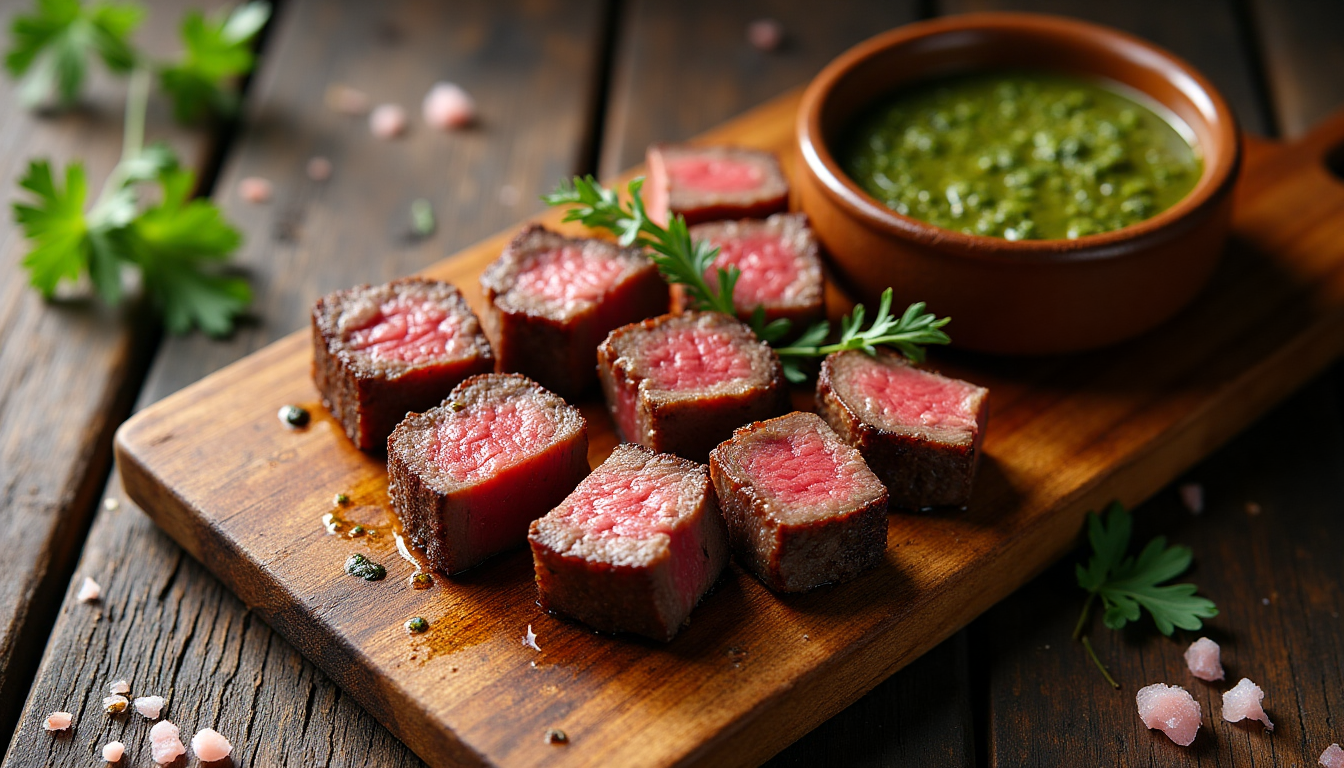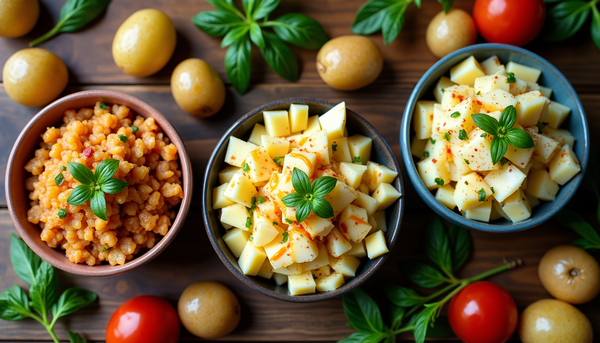Why Chimichurri Steak Bites Changed How I Think About Cooking

Why Chimichurri Steak Bites Changed How I Think About Cooking
Look, I'm gonna be honest with you. Three months ago, I would've rolled my eyes at another "quick steak bites" recipe. Seemed like every food blogger was pushing these bite-sized everything recipes, and frankly? Most of them were just regular dishes chopped up for the 'gram.
Then I actually made chimichurri steak bites. And something clicked.
This isn't really about the recipe – though it's fantastic and I'll share exactly how to nail it. This is about why a simple technique like this can completely shift how you approach weeknight cooking. And why, if you've ever felt intimidated by cooking steak or thought you needed fancy skills to make restaurant-quality food, this might be the confidence builder you've been looking for.
The Real Game Changer (Hint: It's Not the Chimichurri)
Don't get me wrong – chimichurri is incredible. That bright, garlicky, herb-packed punch that cuts through rich meat? Chef's kiss. But the real magic here is learning to sear properly without the pressure of getting a whole steak right.
See, when you're working with bite-sized pieces, you get multiple chances to practice that perfect sear. Mess up one batch? You've got another round coming. Each piece teaches you something about heat control, timing, and when that Maillard reaction is actually happening.
I used to be the guy who'd press down on steaks with a spatula (I know, I know) because I was anxious about whether they were cooking properly. Working with steak bites forced me to develop patience and actually listen to what was happening in the pan.
The sizzle tells you everything. High, aggressive sizzling means your pan's hot enough. When it starts to quiet down, that's when you flip. No guesswork, no poking with a thermometer every thirty seconds.
The Technique That Actually Matters (And Why Everyone Gets It Wrong)
Here's what most recipes won't tell you: the secret isn't in the seasoning blend or the type of oil you use. It's in the prep and the patience.
First, the prep nobody talks about:
Pat those steak pieces dry. I mean really dry. I use about four paper towels and press each piece individually. Moisture is the enemy of a good sear, and surface moisture will steam your meat instead of browning it.
Cut your pieces uniform. This isn't about Instagram aesthetics – it's about everything finishing at the same time. Aim for 1-inch cubes, but honestly? Measuring with your eye is fine once you get the hang of it.
The seasoning setup:
Salt, pepper, smoked paprika. That's it. The smoked paprika isn't just for flavor – it helps with color development too. Season everything in a bowl first, then let it sit for 10 minutes while your pan heats up. This gives the salt time to start working.
The searing process (where most people lose their nerve):
Heat your pan first. I use cast iron because I'm that guy, but a heavy-bottomed stainless steel pan works fine too. Medium-high heat, add your oil when the pan's hot. The oil should shimmer immediately.
Add your steak pieces in a single layer. You should hear that aggressive sizzle. If you don't? Your pan wasn't hot enough.
Now here's the hard part: leave them alone. Don't move them. Don't check them. Don't even think about them for at least 2 minutes. Maybe 3 if you cut them a bit larger.
The steak will release when it's ready. If you try to flip and it sticks? It's not done searing yet.
Where Everyone Messes Up (And How to Fix It)
Mistake #1: Crowding the pan
I get it. You want to cook everything at once and get dinner on the table. But cramming too many pieces in the pan drops the temperature and creates steam. Cook in batches if you need to. Your first batch will stay warm while you finish the second.
Mistake #2: Moving the meat around
Stop it. Seriously. Every time you flip or move a piece before it's properly seared, you're starting the browning process over. Let the pan do its job.
Mistake #3: Adding the chimichurri too early
Fresh herbs don't like high heat. They'll turn dark and lose that bright, vibrant flavor you're after. Wait until the steak comes off the heat, then toss with the sauce.
Mistake #4: Making chimichurri too far ahead
Yeah, it can be made in advance, but it's best within the first hour. After that, the acids start breaking down the herbs and you lose some of that punch.
The Chimichurri That Actually Works
Most chimichurri recipes are fine, but here's what makes the difference: use a mix of parsley and cilantro instead of just parsley. The cilantro adds a different kind of brightness that plays really well with beef.
For the acid component, I do half red wine vinegar, half fresh lemon juice. The vinegar gives depth, the lemon gives brightness.
And here's my controversial take: use a food processor. Hand-chopping herbs is therapeutic and all, but the food processor gives you a better, more even texture that coats the meat properly. Just pulse it – you want chopped, not pureed.
Basic recipe that works every time:
- 1 cup fresh parsley
- 1/2 cup fresh cilantro
- 3 cloves garlic
- 1 small shallot
- 2 tablespoons red wine vinegar
- 2 tablespoons fresh lemon juice
- 1/2 cup good olive oil
- 1/2 teaspoon salt
- 1/4 teaspoon red pepper flakes
Pulse everything except the oil until roughly chopped. With the processor running, slowly add the oil until you get a sauce consistency. Taste and adjust – you might want more acid or salt depending on your preferences.
Beyond the Basic Recipe (Variations That Actually Make Sense)
Once you nail the basic technique, you can run with it in a bunch of directions:
Protein swaps that work:
- Chicken thighs (cook a bit longer, obviously)
- Large shrimp (cook way less – like 1 minute per side)
- Thick portobello caps for vegetarians
Sauce variations:
- Swap chimichurri for romesco if you want something richer
- Try a simple herb butter for something more classic
- Salsa verde works surprisingly well too
Make it a meal:
- Serve over rice or quinoa
- Toss with roasted potatoes
- Add to a salad for protein
The technique stays the same regardless of what direction you take it.
Why This Matters More Than You Think
Here's the thing – learning to properly sear meat is one of those fundamental skills that makes you a better cook across the board. Once you understand heat control and timing with steak bites, you'll approach regular steaks, pork chops, even chicken breasts differently.
You'll stop being afraid of high heat. You'll develop patience in the kitchen. You'll start trusting your senses instead of constantly second-guessing yourself.
And honestly? There's something satisfying about nailing a technique that intimidated you before. Every time I make these now, I remember being the guy who was nervous about cooking any kind of steak. Now my friends ask me to handle the meat when we're grilling together.
The Real Talk Section
Let me be straight with you – your first batch might not be perfect. Mine wasn't. I overcooked about half the pieces and the chimichurri was too acidic because I went heavy on the vinegar.
But here's what's great about this recipe: the stakes are low. You're not dealing with an expensive ribeye that you might ruin. Steak bites are forgiving, and even if some pieces get a little more done than you wanted, they'll still taste good with that chimichurri.
Use it as practice. Pay attention to what happens in the pan. Notice how the meat sounds when it hits the hot oil. Watch for the color changes. Feel how the pieces release when they're properly seared.
This is cooking education disguised as dinner.
Making It Your Own
The beauty of chimichurri steak bites is that once you understand the base technique, you can make it completely your own.
Want more smoke flavor? Add some chipotle powder to your seasoning blend.
Prefer a milder herb sauce? Use all parsley and add some fresh oregano.
Want to sneak in some vegetables? Dice up some bell peppers or onions and throw them in the pan after you remove the steak. They'll cook in the fond (those brown bits) and pick up extra flavor.
Don't have access to great steak? This technique works with less expensive cuts too. Sirloin tip, flat iron, even well-trimmed chuck can work if you cut it against the grain and don't overcook it.
The Bottom Line
Chimichurri steak bites taught me that good cooking isn't about having perfect technique from day one. It's about finding recipes that let you practice fundamental skills in a low-pressure environment.
This recipe gives you multiple opportunities to practice searing in a single meal. It builds confidence with heat control. It teaches you to trust your senses. And at the end of it all, you've got a restaurant-quality dish that took maybe 20 minutes start to finish.
More importantly, it changes how you think about weeknight cooking. Instead of defaulting to the same rotation of safe meals, you start looking for opportunities to practice and improve.
So here's my challenge for you: make this recipe twice in the next two weeks. Pay attention to what happens the second time versus the first. Notice how much more confident you feel with the pan and the timing.
Then come back and tell me it didn't change something about how you approach cooking. Because I'm betting it will.
And if you completely mess it up the first time? Well, that's what takeout apps are for. But try again the next week. Trust me on this one.




